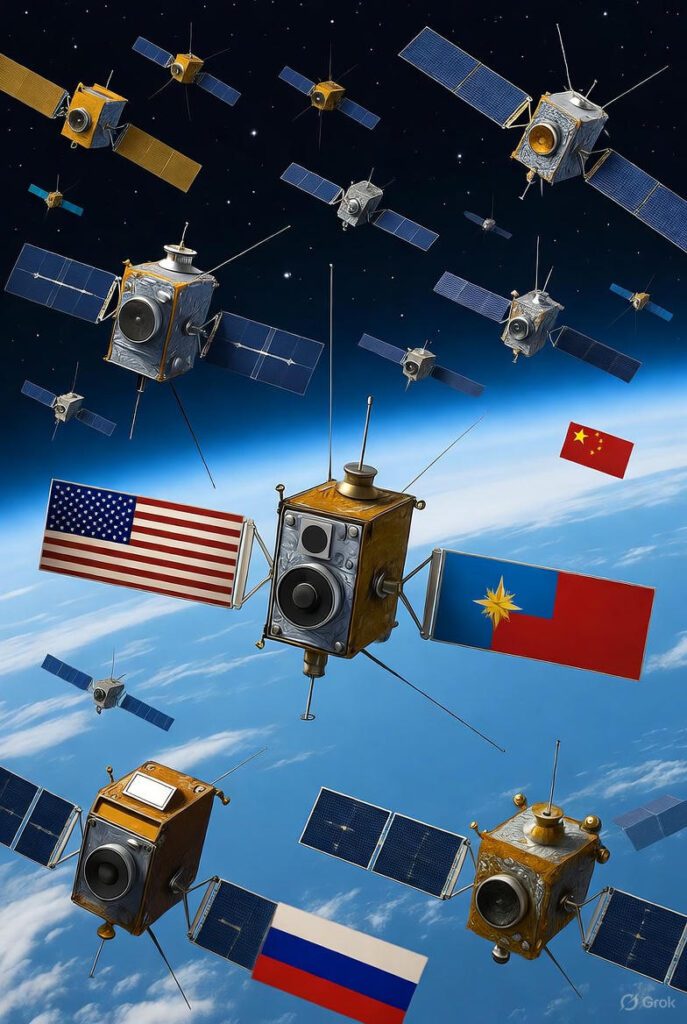
The Race for Space: How Nations Are Scrambling to Grab Chunks of the Earth’s Atmosphere
In the vast expanse above our heads, where the blue sky fades into the black void, a silent battle is unfolding. It’s not for land or sea, but for the invisible highways of Earth’s atmosphere—orbital slots that power everything from your Netflix binge to global military strategies. As of 2025, over 11,000 active satellites circle our planet, with another 30,000 chunks of debris hurtling at speeds up to 17,500 miles per hour. This isn’t science fiction; it’s the new space race, where nations and tech giants are racing to claim “chunks” of Low-Earth Orbit (LEO) and Geostationary Orbit (GEO), turning the heavens into a crowded parking lot.
Gone are the days of Apollo moonshots. Today’s competition is about mega-constellations, thousands of small satellites beaming internet, spying on rivals, and laying the groundwork for space-based economies. With investments topping $400 billion, the stakes couldn’t be higher. Who controls these orbits controls data flows, economic edges, and even wartime advantages. But as launches surge China alone upped its launches by 30% this year the risks of collisions, interference, and escalation loom large. This blog dives into the frenzy, unpacking why it’s happening, who’s leading, and what it means for our connected world. Whether you’re a policy wonk, a space enthusiast, or just curious about why your Starlink bill might skyrocket, here’s your guide to the orbital gold rush.
The Orbital Real Estate Boom: Why Every Nation Wants a Piece
Imagine Earth’s atmosphere as prime real estate: limited space, skyrocketing demand, and fierce bidding wars. Orbital slots aren’t infinite. LEO, hugging the planet at 300 to 1,200 miles up, are ideal for fast internet and imaging but get congested fast. GEO, at 22,000 miles, offers fixed positions for weather watches and TV broadcasts but demands precise “parking spots” to avoid signal clashes. The driver? Mega-constellations. SpaceX’s Starlink, with over 6,000 birds aloft and plans for 42,000 more, aims to blanket the globe in high-speed Wi-Fi, leapfrogging fiber optics in remote spots like rural Africa or Pacific islands. Competitors like Amazon’s Project Kuiper and China’s GuoWang are hot on its heels, each vying for spectrum bands—those radio frequencies that let satellites chat without static. But it’s not just connectivity. These orbits enable precision agriculture for farmers tracking crop health via satellite eyes, disaster response for aid workers mapping floods in real-time, and even autonomous vehicles relying on uninterrupted GPS. For businesses, it’s a game-changer: e-commerce in under-served markets could add trillions to global GDP. No surprise then, that this scramble raises eyebrows. With launches hitting record highs—over 2,500 in 2024 alone—the atmosphere risks becoming a junkyard, endangering the very assets everyone’s fighting over. This boom traces back to miniaturization tech, slashing satellite costs from millions to thousands per unit. Reusable rockets like Falcon 9 make deployment cheap, fuelling a “launch now, ask questions later” mindset. For everyday users, it means better access to education and tele-medicine in off-grid areas. But for nations, it’s also strategic: control the orbit, control the info superhighway.
Key Players: From Superpowers to Startup Titans
No orbital turf war would be complete without the heavy hitters. The United States dominates, registering 82% of new space objects in recent years, thanks to NASA’s partnerships and private firepower. SpaceX, under Elon Musk, isn’t just a company—it’s a de facto arm of U.S. influence, with Starlink terminals lighting up battlefields from Ukraine to Gaza. The Pentagon is eyeing orbital assets for everything from drone swarms to hypersonic missile tracking, while the LAUNCH Act, pushed through Congress in September 2025, funnels billions into countering rivals.
China’s surging ahead too, in this arena of “unmanaged competition.” Beijing’s space program, once secretive, now boasts the world’s busiest launch site. Projects like the Tiantong satellite phone network and a 13,000-satellite GuoWang constellation mirror Starlink’s ambitions, but with a twist: dual-use tech for civilian apps and military edge. In 2025, China notched over 100 launches, testing anti-satellite weapons and probing U.S. defences. Experts warn this could tip the scales in Asia-Pacific tensions, where orbital intel sways naval games.
Russia, the old Cold War champ, plays defence. Hit by sanctions, Moscow’s leaning on rugged GLONASS GPS alternatives and debris-clearing tech demos. Yet, its 2021 Cosmos-1408 test—blasting an old satellite into 1,500 debris pieces—still haunts talks, symbolizing Moscow’s willingness to weaponize space if pushed.
Don’t sleep on emerging powers. India’s ISRO launched 100 satellites in one go back in 2017 and now eyes a regional constellation for disaster monitoring. The European Space Agency (ESA) coordinates Galileo nav sats across 22 nations, emphasizing sustainability with its “Zero Debris” pledge. And private players? OneWeb (UK-backed) and Relativity Space are carving niches, but tensions brew over foreign ownership—like U.S. bills blocking Chinese stakes in American firms.
In this multipolar scrum, alliances form fast: QUAD nations (U.S., India, Japan, Australia) share orbital data, while BRICS (Brazil, Russia, India, China, South Africa and more nations joining-in) push for equitable access. For users worldwide, this means diverse options—cheaper broadband in Latin America via Viasat, or secure comms for African miners via SES.
Geopolitical Fault Lines: Orbits as the New Battleground
Space was meant to be a demilitarized zone, but 2025’s headlines scream otherwise. The U.S.-China rivalry, dubbed “Orbital Rivalry,” extends from cis-lunar paths to LEO parking. Washington’s fretting over Beijing’s “fractionated” satellites—modular designs that reassemble mid-orbit for sneaky manoeuvres. A September report highlighted how China’s launches could flood slots, forcing U.S. assets to dodge or delay.
Tensions peaked in Ukraine, where Starlink’s 20,000+ terminals kept Kyiv connected, but Musk’s selective activations sparked sovereignty debates. Russia countered with jamming tech, proving orbits aren’t neutral. In the Indo-Pacific, India, with a successful anti-satellite test, joined a club including the U.S. and China, signalling deterrence: touch my birds, lose yours.
Geopolitics bleeds into economics too. Spectrum auctions at the ITU (International Telecommunication Union) turn into diplomatic knife fights, with developing nations decrying “first-come, first-served” rules that favour launch-rich powers. Wealthy countries snag prime GEO slots for broadcasting empires, while equatorial states like Ecuador claim “natural” rights to overhead orbits under the Moon Agreement—though few ratify it.
For global users, this means uneven access: urban elites get gigabit speeds, while rural folks haggle over delayed packets. But it also fosters innovation—think blockchain-secured orbital data for transparent aid distribution. The wildcard? Cyber threats. Hack a constellation, and you black out a continent’s finance sector. Nations are scrambling for “space norms,” like the U.S.-led Artemis Accords, but enforcement lags.
The Growing Shadow: Space Debris and the Ticking Time Bomb
Every silver lining has debris. With 40,000 trackable objects zipping around—as per ESA’s 2025 report—the risk of Kessler Syndrome (a chain-reaction collision cascade) isn’t hyperbole. A single smash could render parts of the LEO unusable for generations, stranding billions offline. Mitigation Is the buzzword. ESA’s Zero Debris approach mandates end-of-life de-orbits within five years, while Japan’s August 2025 framework sets global rules for removal ops, like robotic arms snagging defunct sats. MIT’s scoring system rates operators on collision avoidance and data sharing, pressuring laggards. International funds are floated—UNOOSA’s compendium calls for pooled resources to fund cleanups, with wealthier nations footing bills. Challenges persist: Active removal looks like attacks to rivals, blurring lines between janitorial bots and weapons. China’s and Russia’s manoeuvres, like proximity ops near U.S. assets, fuel paranoia in America. For users, debris means insurance hikes on launches and spotty service—imagine your Zoom call glitching mid-presentation because a bolt from 1986 crossed paths.
Yet, hope glimmers. Re-entry tech, like drag sails that hasten atmospheric burn-up, and AI predictors spotting near-misses are game-changers. By prioritizing sustainability, nations could turn crisis into collaboration, ensuring orbits remain viable for all.
Navigating the Legal Cosmos: Rules for the Orbital Commons
Outer space is “province of all mankind,” as per the 1967 Outer Space Treaty, but specifics are murky. The ITU allocates orbital slots and frequencies via filings—first to plan and launch wins priority. But mega-constellations upend this: Starlink’s swarm doesn’t fit neat GEO boxes, sparking disputes over interference.
UNOOSA registers objects, enforcing state liability for damages—think a satellite shard puncturing your neighbour’s roof. Yet, enforcement’s toothless; arbitration via the Permanent Court handles rare clashes, like Russia’s slot squabbles with Intelsat.
Emerging issues: Corporate sovereignty. When SpaceX dictates Ukraine aid, who governs? Calls grow for updated treaties, balancing innovation with equity. Developing nations push “common heritage” for LEO resources, eyeing future mining. For practical users, clearer rules mean reliable service—no more frequency wars disrupting your podcast.
Charting the Stars: What’s Next in the Space Scramble?
By 2030, 100,000 satellites could possibly orbit earth, birthing a $1 trillion space economy. Lunar gateways and Mars relays will demand cis-lunar slots, escalating the race. AI integration promises smarter traffic management, dodging debris autonomously. Sustainability mandates will bite: Expect “debris taxes” on launches and incentives for green designs. Geopolitically, hybrid public-private pacts—like U.S.-ESA moon bases—could cool tensions, while BRICS counters with affordable access for the Global South. For innovators, opportunities abound: orbital data analytics for climate modelling, or VR tours via sat-linked headsets. But the watchword? Cooperation. Unilateralism risks escalation; shared governance ensures more equitable benefits.
